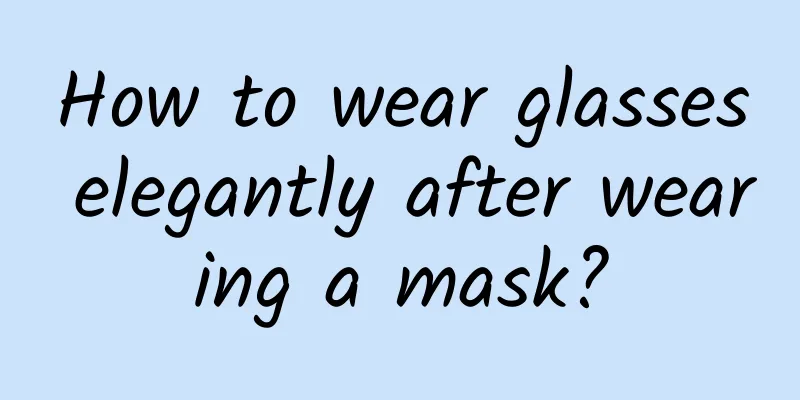How to wear glasses elegantly after wearing a mask?

|
Since I put on a mask, I have to do one more thing when walking on the street: press the metal strips on both sides of the nose bridge of the mask with my hands. Especially in winter, because the hot air you exhale will creep into the glasses through the gap between the mask and your face, leaving a layer of water droplets on the mirror surface like a rising tide, that is, fog; if you are lucky, the fog will soon dissipate when the "tide recedes". But if you have to walk into the subway station from the outside, you will find that the outside of the glasses is also covered with a layer of fog. Copyright image, no permission to reprint The fogging of glasses is actually the process of condensing water vapor into water due to the temperature difference between the glasses and the surrounding air. It is worth mentioning that there are several additional layers of film on the lenses to reduce reflection, waterproof, oil-proof and blue light-proof, etc. They are often hydrophobic materials, making it difficult for water to wet the mirror surface, thus forming water droplets. These small water droplets will cause the incident light to scatter in all directions, making it difficult for people to see clearly. At this point, if you passively wait for the water droplets on your glasses to evaporate and dissipate the fog, you may have to continue walking forward for a few minutes with such a pair of hazy glasses. But apart from that, what else can you do? Dimos Poulikakos is the director of the Department of Thermodynamics at ETH Zurich and the founder of the Thermodynamics Laboratory for Emerging Technologies at the school. He mainly conducts research related to interfaces and thermodynamics. Poulikakos and his colleagues are very interested in the fogging of glasses and have been thinking about how to develop a new coating for glasses since about 6 years ago. They hope that this coating can not only quickly defog or prevent fogging, but also match existing technologies to achieve large-scale production. Recently, Poulikakos' team published their latest results in the journal Nature Nanotechnology. 01 Let your glasses heat themselves? The special thing about this new technology is that it imitates the defroster on the rear window of a car. People who own a car should know that the horizontal lines on the rear window of a car are actually heating wires, which are used to heat the rear window to accelerate evaporation and achieve the effect of defrosting/fogging. However, compared to actively providing energy (such as electricity) manually, Pulikakos and his colleagues thought, is it possible to heat part of the lens in a daily environment (with a certain amount of light) to reduce the temperature difference, thereby preventing the formation of fog or speeding up the defog speed? Copyright image, no permission to reprint "People usually use dark surfaces to absorb light and convert it into heat," said Efstratios Mitridis, a doctoral student in Pulikakos' team. But we know that the glasses must be transparent enough, so they need to design a special transparent coating that has both high enough light transmittance and can achieve the same effect as a dark surface: absorbing enough infrared light to increase the temperature of the object. Scientists already know that for metal nanoparticles (which can be considered a special kind of plasma), resonance occurs when the oscillation frequency of free electrons on the metal surface is comparable to the frequency of incident light, thus producing a strong local absorption effect on the corresponding wavelength of light while allowing light of other wavelengths to pass through. Its resonance frequency often appears in the visible light band. Nowadays, in some artificial optical metamaterials, scientists often embed specific forms of nanoparticles on different surfaces and stack them to form a multi-layer structure. They can adjust the size, position and direction of the nanoparticles, or change the thickness of each layer of nanoparticles to regulate the interaction between light and nanoparticles, so that the material exhibits different optical properties. For example, the plasma resonance frequency is broadened to the near-infrared band. This is also a strategy that Pulikakos' team finally chose. The research team's idea is to prepare a metamaterial coating that allows as much visible light as possible to pass through while absorbing as much near-infrared light as possible. Image source: Reference [1] Along these lines, they first reported their coating in 2019, which consists of a layer of titanium dioxide and a layer of gold nanoparticles stacked alternately and repeatedly. "Our coating absorbs infrared light from the sun and some visible light," said Christopher Walker, the first author of the study. "The absorbed light is converted into heat energy." This can increase the temperature of the lens by 3 to 4 degrees Celsius, thereby reducing the temperature difference that causes the glasses to fog up. The study was published in the journal Nano Letters. However, the visible light transmittance of this version of the coating is only about 36%, and the absorption rate is about 30%~40% (taking visible light as an example, the transmittance + absorption + reflectance of visible light = 1). This is likely to affect the transmittance of the lens, as well as the final clarity and distortion. Therefore, in the next three years, Pulikakos and his colleagues have been trying to optimize the material structure to find eyeglass coatings with better optical effects. Where will the mutation of properties appear? 02 Nanogold film The percolation threshold and percolation phenomenon are often used in conductive composite materials, which have a very important characteristic: their conductivity increases nonlinearly with the increase of the volume fraction of conductive particles, and suddenly increases at a certain critical value, with a change range of more than 10 orders of magnitude, and then decreases nonlinearly. Based on the cause of the percolation phenomenon, we may speculate that as the concentration of gold nanoparticles increases, when these gold nanoparticles form a kind of continuous network, the optical properties of the material suddenly increase rapidly. This research team thought and did so. They wanted to use this percolation concept to find the optical performance threshold of the eyeglass coating. Compared with the gold nanoparticles used in 2019, they chose to use a traditional thermal evaporation process to prepare nanogold films this time. According to them, when gold is deposited on the substrate, islands will be formed first, but these islands are small and independent of each other, making it difficult for collective resonance to occur; as more gold is deposited, these islands will be electrically connected to each other, forming a larger, interconnected network. In fact, this layer of nanogold film is sandwiched between two layers of titanium dioxide. When the thickness of the nanogold film is 4.75 nanometers, the material of this structure has the maximum near-infrared light absorption rate - about 36.9%, and has a high visible light transmittance (67.1%), and almost does not absorb visible light - for example, near-infrared light absorption rate = absorbed near-infrared light/absorbed incident light. More importantly, this new coating can even heat up the glasses by 8.3°C under the radiation of 1 sun (after calculation, physicists have confirmed that the power density of solar radiation on the earth is about 1000 watts/square meter, so it is simply referred to as 1 sun radiation); even under the radiation of 0.6 suns, it can heat up by 5.4°C. One of the lenses was coated with their newly developed metamaterial, and the other was untreated. The results showed that the metamaterial coating prevented the lens from fogging, while the untreated lens fogged up completely. Image source: Reference [1] Of course, in actual application, we may encounter situations where the sunlight radiation is very weak. Can this coating still play a heating role then? Fortunately, the glasses have two lenses, so it is easy to conduct a control experiment: one of the lenses is coated with their newly developed metamaterial, and the other is untreated. First, Pulikakos' team placed the glasses outdoors and exposed them to sunlight (intensity of 0.2-0.3 sun radiation) for 5 minutes. Then, the researchers wearing masks put on the glasses and exhaled. Obviously, the untreated lens fogged up completely, while the lens coated with the metamaterial maintained full visibility even in this non-ideal condition. The researchers took the coated material to the Swiss mountains for testing. Image source: Reference [1] Pulikakos and his colleagues even took polyester sheets and silica wafers coated with this coating to the mountains of Switzerland to demonstrate its anti-fog and defogging capabilities in harsh outdoor conditions. 03 Going to market They have filed a patent application for this and hope to be able to go to market. But when you think of the gold in the coating, you may be deterred. But scientists have already calculated it for you in advance and found that it is not that expensive: "Since the thickness of the nanogold film is less than 5 nanometers, the overall coating only requires very little gold. Specifically, each square meter of coating contains 100 mg of gold, which means that a pair of glasses requires about 0.3 mg of gold, which is equivalent to 0.017 US dollars (equivalent to 11.5 cents in RMB)." Iwan Haechler, the first author of the new study, said. Of course, the overall coating and other prices are not included. Speaking of products, the main product on the market is anti-fog wipes, which prevent fogging by leaving a film on the lens through wiping. They contain hydrophilic or hydrophobic materials, but the original lens coating may be damaged during the wiping process. As for the principle, they mainly change the contact angle between the water droplet and the lens surface by adjusting the surface wettability, which is completely different from the strategy of the Prikakos team. For example, superhydrophilic materials can make water droplets spread out to form a water film to allow light to pass through. Therefore, the lens appears to be transparent to the naked eye, but it does not actually prevent the condensation of water vapor. However, the surface energy of the hydrophilic surface is high, so it is easy to absorb impurities such as dirt, dust, and oil droplets. Just a little impurity can weaken the performance of the superhydrophilic surface. When it comes to super-hydrophobic surfaces, we can imagine dewdrops on a lotus leaf . Super-hydrophobic surfaces mimic the structure of lotus leaves, so that water droplets do not get wet and leave the surface. However, it is extremely challenging to prepare such a perfect bionic structure. Therefore, the water droplets clustered on the surface will not slide off in time as you wish. They are likely to continue to "invade" the surface, causing it to eventually lose its function. As for the newly developed nano-gold lens coatings by Prikakos and his team, they will undoubtedly play an anti-fog and defogging role, but whether they can meet the needs of long-term use and outperform current products remains to be tested. References: [1]https://www.nature.com/articles/s41565-022-01267-1#Sec15 [2]https://pubs.acs.org/doi/10.1021/acs.nanolett.8b04481 [3]https://www.nature.com/articles/s41565-022-01269-z [4]https://doi.org/10.1016/j.pmatsci.2018.09.001 [5]https://doi.org/10.1016/0275-5408(95)00023-2 [6]https://phys.org/news/2019-03-nanotechnology-sunlight-visibility.html [7]https://www.zmescience.com/science/news-science/new-ultrathin-gold-coating-can-make-your-glasses-defog-themselves/ [8]https://www.zmescience.com/other/feature-post/how-to-prevent-your-glasses-from-fogging-when-wearing-a-face-mask/ Author: Wang Yibo Source: Global Science The cover image and the images in this article are from the copyright library Reproduction of image content is not authorized |
>>: Arranged! The fourth phase of the lunar exploration project is fully promoted →
Recommend
Vertical lines and white spots on the nails are a "sign of death"? 4 conditions to be alert to →
In life, most people have smooth and rosy nails, ...
What are the advantages of Baidu information flow that makes it popular with advertisers?
What advantages does Baidu information flow have ...
How can activities attract more users? I summarized these 4 key points
When running events or conducting marketing activ...
oCPC costs remain high? Come and try this method!
When delivering information flow, especially runn...
The first lesson for parents to teach their children about financial literacy
Resources for parents’ first parent-child financi...
What factors do you consider most when buying a USB flash drive?
USB flash drives are definitely the most convenie...
Show off our national treasure 5丨The full-sea-depth manned submersible "Struggler"
Your browser does not support the video tag On Oc...
Product operation strategy: How to carry out user stratification operations?
Pyramid stratification is a method of stratifying...
2020 Huamanlou Finance original full set of tactics video tutorial
Introduction to the 2020 Huamanlou Finance origin...
Crayfish is "very dirty" and eating it will cause rhabdomyolysis. Is it credible?
Along with summer comes people's endless enth...
Apple launches iOS 10.2 Beta2. What are the new changes?
Recently, Apple pushed iOS 10.2 Beta 2 to develop...
How to promote and operate Xiaohongshu? Xiaohongshu promotion tips!
Not long ago, the news about Xiaohongshu conducti...
Do computers have vision? Let computers "see" the world
1. The Birth of Vision In the billions of years s...









